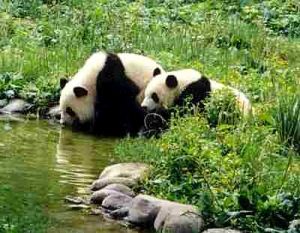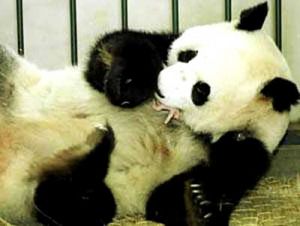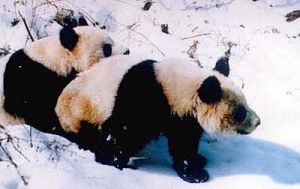Difference between revisions of "Giant panda"
(bKptRnqAgdo) |
imported>Ciic |
||
| (44 intermediate revisions by 13 users not shown) | |||
| Line 1: | Line 1: | ||
| − | + | The '''Giant Panda '''('''大熊猫''') is universally loved, but this peaceful, bamboo-eating member of the [[Bear family]] faces many threats. Its population is small and isolated as its traditional forest habitat in southwest [[China]]'s mountainous areas becomes fragmented. The government has set up more than 30 reserves, but habitat destruction and poaching continues to pose a threat to pandas living outside them. With rapid economic development, it is more important than ever to ensure the giant panda's survival.[[Image:Panda1.jpg|thumb|right]][[Image:Panda2.jpg|thumb|right]][[Image:Panda3.jpg|thumb|right]][[Image:Panda4.jpg|thumb|right]][[Image:Panda5.jpg|thumb|right]][[Image:Panda6.jpg|thumb|right]] | |
| + | |||
| + | Giant pandas are black and white bears that live in temperate-zone bamboo forests in central China. Among the best recognized but rarest animals in the world, they have come to symbolize endangered species and conservation efforts. | ||
| + | |||
| + | {| align="right" border="1" | ||
| + | |+ '''Scientific Classification''': | ||
| + | |- | ||
| + | | Kindom | ||
| + | | Animalia | ||
| + | |- | ||
| + | | Phylum | ||
| + | | Chordata | ||
| + | |- | ||
| + | | Class | ||
| + | | Mammalia | ||
| + | |- | ||
| + | | Order | ||
| + | | Carnivora | ||
| + | |- | ||
| + | | Family | ||
| + | | Ursidae | ||
| + | |- | ||
| + | | Genus | ||
| + | | Ailuropoda | ||
| + | |- | ||
| + | | Species | ||
| + | | A.melanoleuca | ||
| + | |} | ||
| + | |||
| + | == Geographic Distribution == | ||
| + | |||
| + | Giant pandas live in a few mountain ranges in central China’s Sichuan, Shaanxi, and Gansu provinces. They once lived in lowland areas, but farming, forest clearing, and other development now restrict giant pandas to the mountains. | ||
| + | |||
| + | == Habitat == | ||
| + | |||
| + | Giant pandas live in broadleaf and coniferous forests with a dense understory of bamboo, at elevations between 5,000 and 10,000 feet. Torrential rains or dense mist throughout the year characterizes these forests, often shrouded in heavy clouds. | ||
| + | |||
| + | == Physical Description == | ||
| + | |||
| + | A giant panda is bear-like in shape. It has black fur on ears, eye patches, muzzle, legs, and shoulders. The rest of the animal's coat is white. Although scientists do not know why these unusual bears are black and white, some speculate that the bold coloring provides effective camouflage into their shade-dappled snowy and rocky surroundings. The panda's thick, wooly coat keeps it warm in the cool forests of its habitat. Giant pandas have large molar teeth and strong jaw muscles for crushing tough bamboo. Many people find these chunky, lumbering animals to be cute, but giant pandas can be as dangerous as any other bear. | ||
| + | |||
| + | ==== Size ==== | ||
| + | |||
| + | About the size of an American black bear, giant pandas stand between two and three feet tall at the shoulder (on all four legs), and reach four to six feet long. Males are larger than females, weighing up to 250 pounds in the wild. Females rarely reach 220 pounds. | ||
| + | |||
| + | == Status == | ||
| + | |||
| + | The giant panda is listed as endangered in the World Conservation Union's (IUCN's) Red List of Threatened Animals. It is one of the most critically endangered species in the world. There are about 1,000 left in the wild. About 140 pandas live in zoos and breeding centers around the world, mostly in China. | ||
| + | |||
| + | == Life Span == | ||
| + | |||
| + | Scientists are not sure how long giant pandas live in the wild, but they are sure it is shorter than lifespans in zoos. Chinese scientists have reported zoo pandas as old as 35. | ||
| + | |||
| + | == Diet == | ||
| + | |||
| + | A wild giant panda’s diet is almost exclusively (99 percent) bamboo. The balance consists of other grasses and occasional small rodents or musk deer fawns. In zoos, giant pandas eat bamboo, sugar cane, rice gruel, a special high-fiber biscuit, carrots, apples, and sweet potatoes. | ||
| + | |||
| + | == Social Structure == | ||
| + | |||
| + | Adult giant pandas are generally solitary, but they do communicate periodically through scent marks, calls, and occasional meetings. Offspring stay with their mothers from one and a half to three years. | ||
| + | |||
| + | <br> | ||
| + | |||
| + | == R&D == | ||
| + | |||
| + | ==== Research and Breeding Bases ==== | ||
| + | |||
| + | The purpose of these research bases, also called the transfer protection of the giant pandas, is to enlarge the captive breeding population by the study of artificial panda breeding and upgrading the management of their nurture. The artificially bred pandas will return to nature finally to complement and expand the wild population. Therefore, the bases are supporting, supplementing and promoting the giant panda’s habitat protection project. | ||
| + | |||
| + | China has two major panda research stations, as well as important research program at the [[Beijing Zoo]] and academic institutions. Perhaps the most famous research base is the China Research and Conservation Center for the Giant Panda in [[Wolong]], lying in the [[Wolong Nature Reserve]] and under the jurisdiction of the [[State Forestry Administration]]. Established in the early 1980s, the center has made tremendous progress in captive breeding techniques. There are more than 40 pandas in captivity in the center, accounting for 30 percent of the total amount of captive pandas in the world. The center has artificially bred 31 fetuses, with 50 babies produced, of which 37 survived. Among them, six fetuses, totaling 12 babies were born in 2000, and 11 survived. | ||
| + | |||
| + | Most of the giant pandas in the center in Wolong stay individually in cages, which are in fact large enclosures, each consisting of an in-door room and an out-door courtyard. Those giant pandas about to be released back to the wild will be put in semi-nature enclosures for a long enough period for them to adapt to the natural environment. The semi-nature enclosures are very large wild areas, but protected by border fences. Although food has to be provided, the giant pandas will sleep there, eat there and recover their natural survival skills until they can be released back to the wild. | ||
| + | |||
| + | On Oct.11, 2012, the reserve center sent a two-year-old artificially bred male panda--"Taotao"--to wild, signaling a second trial afetr their first failed attempt to keep a five-year-old panda "Xiangxiang" well in nature, six years ago. Xiangxiang was died short after bouts of fights with its peers. Now the scentists are taking a close look at Taotao. | ||
| + | |||
| + | Another major panda research base is the [[Chengdu Giant Panda Research Base]], which operates under the authority of the [[Ministry of Construction]]. The base has many kinds of enclosures simulating the wild natural environment for the adult giant panda, sub-adult giant panda, baby giant panda and lesser panda and other animals respectively. Up to 2000, the base has artificially bred 40 fetuses, totaling 61 babies, of which 32 survived. In 1995, the base was honored by the United Nations Environment Development Organization in its list of “Global Top 500.” | ||
| + | |||
| + | '''"Pandas--a meal for primitive Sichuan man"''': | ||
| + | |||
| + | The Chinese palaeoanthropologist Wei Guangbiao revealed in Oct., 2012, that the archaic tribes inhabiating in Sichuan Province used to take pandas, who sizes were much smaller than they are today, as their meals. | ||
| + | |||
| + | == Campaigns for the protection of giant pandas == | ||
| + | |||
| + | With their mild and cute looks, the pandas have won immense favors worldwide. People all over the world are organizing various activities in promoting the protection of the rare specy. | ||
| + | |||
| + | In Oct., 2012, a contest in choosing three ambassadors for giant panda conservation was held in Singapore. | ||
| + | |||
| + | [[Category:Endangered_species]] [[Category:National_symbols]] | ||
Latest revision as of 01:48, 17 December 2013
The Giant Panda (大熊猫) is universally loved, but this peaceful, bamboo-eating member of the Bear family faces many threats. Its population is small and isolated as its traditional forest habitat in southwest China's mountainous areas becomes fragmented. The government has set up more than 30 reserves, but habitat destruction and poaching continues to pose a threat to pandas living outside them. With rapid economic development, it is more important than ever to ensure the giant panda's survival.
Giant pandas are black and white bears that live in temperate-zone bamboo forests in central China. Among the best recognized but rarest animals in the world, they have come to symbolize endangered species and conservation efforts.
| Kindom | Animalia |
| Phylum | Chordata |
| Class | Mammalia |
| Order | Carnivora |
| Family | Ursidae |
| Genus | Ailuropoda |
| Species | A.melanoleuca |
Contents
Geographic Distribution
Giant pandas live in a few mountain ranges in central China’s Sichuan, Shaanxi, and Gansu provinces. They once lived in lowland areas, but farming, forest clearing, and other development now restrict giant pandas to the mountains.
Habitat
Giant pandas live in broadleaf and coniferous forests with a dense understory of bamboo, at elevations between 5,000 and 10,000 feet. Torrential rains or dense mist throughout the year characterizes these forests, often shrouded in heavy clouds.
Physical Description
A giant panda is bear-like in shape. It has black fur on ears, eye patches, muzzle, legs, and shoulders. The rest of the animal's coat is white. Although scientists do not know why these unusual bears are black and white, some speculate that the bold coloring provides effective camouflage into their shade-dappled snowy and rocky surroundings. The panda's thick, wooly coat keeps it warm in the cool forests of its habitat. Giant pandas have large molar teeth and strong jaw muscles for crushing tough bamboo. Many people find these chunky, lumbering animals to be cute, but giant pandas can be as dangerous as any other bear.
Size
About the size of an American black bear, giant pandas stand between two and three feet tall at the shoulder (on all four legs), and reach four to six feet long. Males are larger than females, weighing up to 250 pounds in the wild. Females rarely reach 220 pounds.
Status
The giant panda is listed as endangered in the World Conservation Union's (IUCN's) Red List of Threatened Animals. It is one of the most critically endangered species in the world. There are about 1,000 left in the wild. About 140 pandas live in zoos and breeding centers around the world, mostly in China.
Life Span
Scientists are not sure how long giant pandas live in the wild, but they are sure it is shorter than lifespans in zoos. Chinese scientists have reported zoo pandas as old as 35.
Diet
A wild giant panda’s diet is almost exclusively (99 percent) bamboo. The balance consists of other grasses and occasional small rodents or musk deer fawns. In zoos, giant pandas eat bamboo, sugar cane, rice gruel, a special high-fiber biscuit, carrots, apples, and sweet potatoes.
Social Structure
Adult giant pandas are generally solitary, but they do communicate periodically through scent marks, calls, and occasional meetings. Offspring stay with their mothers from one and a half to three years.
R&D
Research and Breeding Bases
The purpose of these research bases, also called the transfer protection of the giant pandas, is to enlarge the captive breeding population by the study of artificial panda breeding and upgrading the management of their nurture. The artificially bred pandas will return to nature finally to complement and expand the wild population. Therefore, the bases are supporting, supplementing and promoting the giant panda’s habitat protection project.
China has two major panda research stations, as well as important research program at the Beijing Zoo and academic institutions. Perhaps the most famous research base is the China Research and Conservation Center for the Giant Panda in Wolong, lying in the Wolong Nature Reserve and under the jurisdiction of the State Forestry Administration. Established in the early 1980s, the center has made tremendous progress in captive breeding techniques. There are more than 40 pandas in captivity in the center, accounting for 30 percent of the total amount of captive pandas in the world. The center has artificially bred 31 fetuses, with 50 babies produced, of which 37 survived. Among them, six fetuses, totaling 12 babies were born in 2000, and 11 survived.
Most of the giant pandas in the center in Wolong stay individually in cages, which are in fact large enclosures, each consisting of an in-door room and an out-door courtyard. Those giant pandas about to be released back to the wild will be put in semi-nature enclosures for a long enough period for them to adapt to the natural environment. The semi-nature enclosures are very large wild areas, but protected by border fences. Although food has to be provided, the giant pandas will sleep there, eat there and recover their natural survival skills until they can be released back to the wild.
On Oct.11, 2012, the reserve center sent a two-year-old artificially bred male panda--"Taotao"--to wild, signaling a second trial afetr their first failed attempt to keep a five-year-old panda "Xiangxiang" well in nature, six years ago. Xiangxiang was died short after bouts of fights with its peers. Now the scentists are taking a close look at Taotao.
Another major panda research base is the Chengdu Giant Panda Research Base, which operates under the authority of the Ministry of Construction. The base has many kinds of enclosures simulating the wild natural environment for the adult giant panda, sub-adult giant panda, baby giant panda and lesser panda and other animals respectively. Up to 2000, the base has artificially bred 40 fetuses, totaling 61 babies, of which 32 survived. In 1995, the base was honored by the United Nations Environment Development Organization in its list of “Global Top 500.”
"Pandas--a meal for primitive Sichuan man":
The Chinese palaeoanthropologist Wei Guangbiao revealed in Oct., 2012, that the archaic tribes inhabiating in Sichuan Province used to take pandas, who sizes were much smaller than they are today, as their meals.
Campaigns for the protection of giant pandas
With their mild and cute looks, the pandas have won immense favors worldwide. People all over the world are organizing various activities in promoting the protection of the rare specy.
In Oct., 2012, a contest in choosing three ambassadors for giant panda conservation was held in Singapore.





